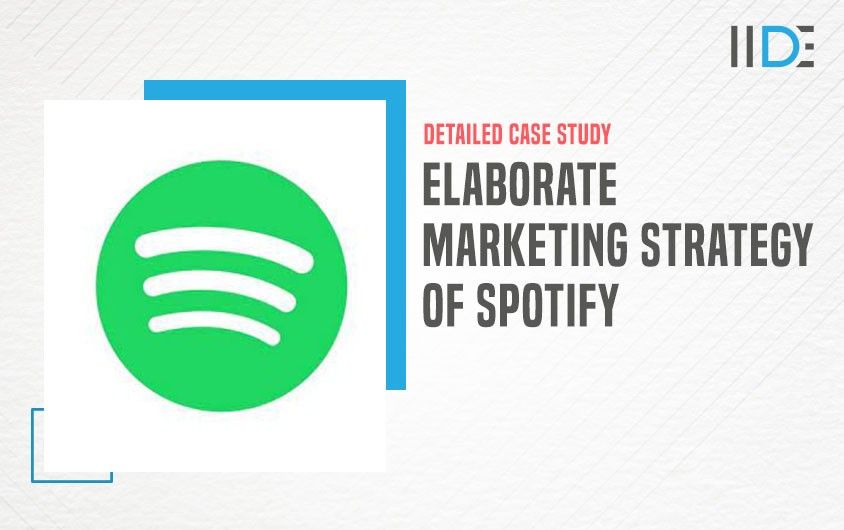About Spotify

Source: Google
Spotify, founded in 2006 by Daniel Ek and Martin Lorentzon in Stockholm, Sweden, revolutionised music streaming with its freemium model. The brand’s mission is to unlock the potential of human creativity by enabling artists to live off their art and helping fans enjoy and be inspired by it. Spotify boasts over 345 million active users and 155 million premium subscribers globally, offering a vast library of over 70 million tracks.
If you’re interested in learning how Spotify uses digital marketing in its marketing strategies and make a career in this dynamic field, pursuing a digital marketing course can provide valuable insights and skills that align with modern industry requirements.
What’s New With Spotify
- Spotify reported €9.67 billion in revenue for FY 2022, a 16% increase from the previous year (Source: Spotify Annual Report 2022). Spotify’s marketing strategy is one of the main reasons behind this growth.
- The platform has 345 million+ active users and 155 million+ premium subscribers (Source: Statista).
- Spotify is available in 178 markets worldwide, continuing its global expansion (Source: Spotify Corporate).
Curious to learn about how brands like Spotify leverage market trends in their marketing campaigns and earn such high revenues? Check out our best digital marketing course online to learn and implement these learnings in the real world.
1. Business News
Spotify acquired audiobook platform Findaway in 2023, expanding its content offerings beyond music and podcasts (Source: TechCrunch).
2. Product Launch
In 2023, Spotify launched ‘Spotify HiFi’, offering lossless audio quality for premium subscribers, catering to audiophiles’ demands (Source: The Verge).
3. Marketing News
As part of its marketing strategy of Spotify, the company ran the ‘Wrapped 2023’ campaign received widespread acclaim, allowing users to share their personalised music listening statistics on social media (Source: Adweek).
4. Celebrity News
Spotify signed an exclusive podcast deal with Prince Harry and Meghan Markle, significantly boosting its podcast segment (Source: BBC).
Want to understand the factors that brands like Spotify consider while designing their marketing strategies? Check out our best online marketing courses to gain insights from a marketer’s perspective.
Buyer Persona for Spotify’s Target Audience
A buyer persona gives a detailed profile of Spotify’s ideal customer. Spotify’s marketing strategy is based on its customer’ motivations, what they like, their challenges, and how they spend their time listening to music online.
After studying this breakdown in detail, it’s no surprise that the marketing strategy of Spotify leverages the use of social media platforms like LinkedIn and Meta to implement their campaigns. Here, the company can feature music recommended by influencers that match the taste of its target audience.
Today, there are many AI tools like ChatGPT that can help you generate content tailored to various social media platforms. Check out our free ChatGPT course and leveraging its power now!
Marketing Strategy of Spotify
Now that we have a little background of Spotify, let us take a look at what their marketing strategies are and how they use these marketing strategies to dominate the music streaming industry.
Segmentation, Targeting and Positioning
Spotify has a diverse customer base with more of their users being from Europe than any other region. Typically, Spotify’s target users are young adults (Millennials and Gen Z). However, Spotify also has a small number of audience of older listeners aged 55 and above.
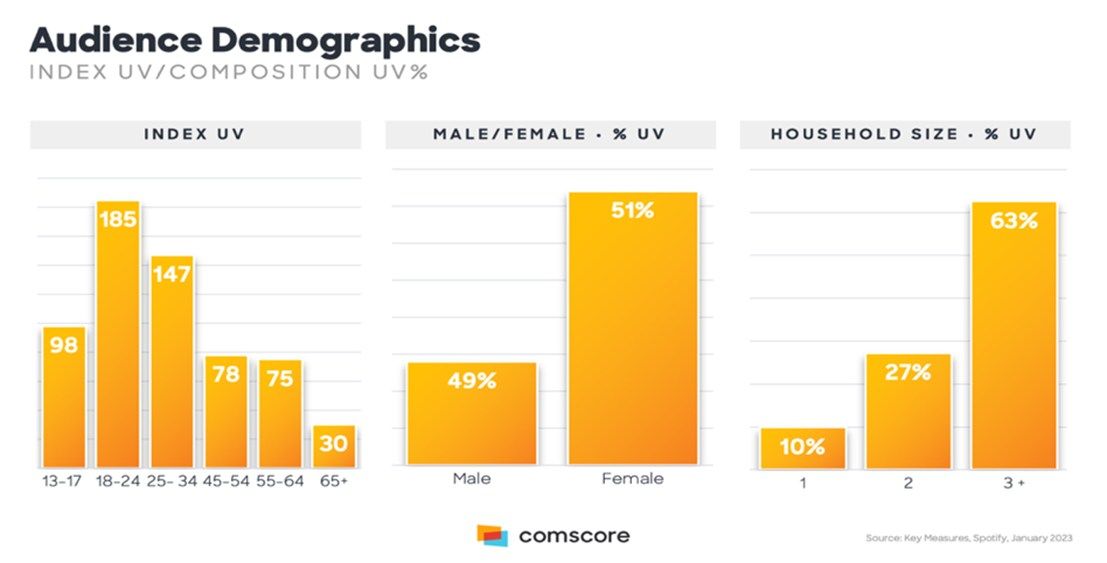
Source: comscore.com
Spotify’s data-driven approach allows it to target users based on their listening habits, demographics, and even moods. To resonate with its diverse audience, Spotify employs a dynamic positioning strategy, promoting itself as a music platform that offers personalised and unique experiences. By leveraging advanced algorithms and user data, Spotify continuously refines its offerings to cater to the specific needs and preferences of its users.
Spotify’s global reach, with a strong presence in various regions, enables it to adapt its marketing strategies to local cultures and trends, ensuring relevance and engagement.
Do you want to learn how segmentation, targeting, and positioning can help brands like Spotify drive success? Join our free digital marketing masterclass to gain a deeper understanding of these concepts.
Marketing Mix of Spotify
Marketing mixes are analysed with a set of components that eventually form a marketing strategy for that particular brand. With Spotify, let’s use a marketing mix of the 4 P’s to understand – Product, Price, Place, and promotion.
1. Product
Spotify’s major product is music streaming. Traditional ways of listening to music were to buy CD tapes and cassettes, and with Spotify coming in it all changed. According to the types of accounts on Spotify, you get the option to download music offline or online. Also, if you have a Premium account, you can select the types of content you want, avoid all advertisements, and much more. Free accounts can play music online only.
2. Price
Of course, we know, we can listen to content for free or by paying a subscription. As a part of Spotify’s strategy, they operate under a freemium pricing model, where free users encounter ads, ultimately generating revenue for Spotify. As per the need of the user, one can choose out of four premium pricing models: Individual (₹744 / month for 1 account), Duo (₹968 / month for 2 accounts), Family (₹1117 / month for up to 6 accounts), Student (₹371 / month for 1 account). Prices differ from one country to the next.
3. Place
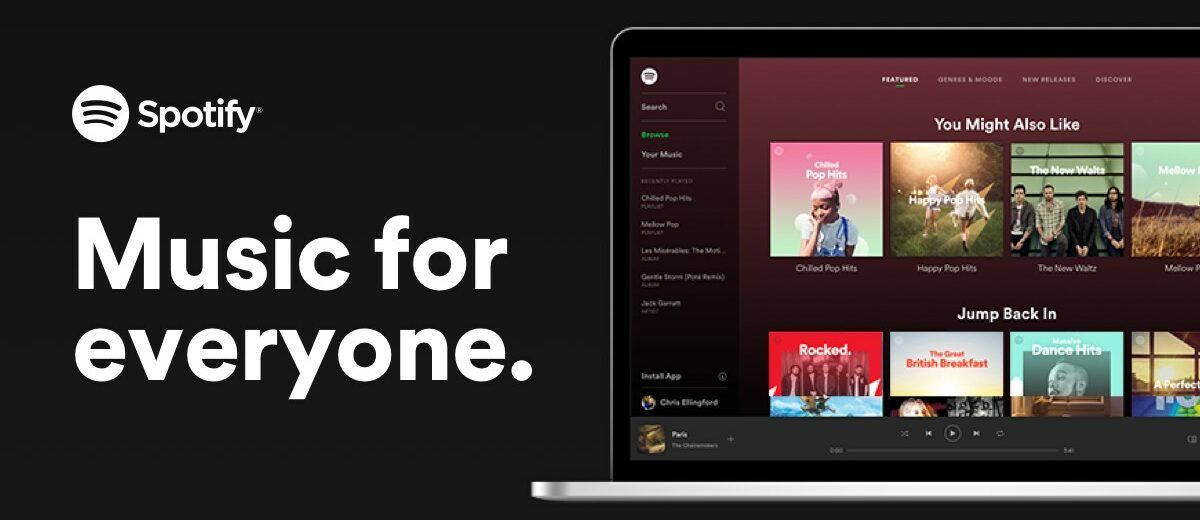
Source: Google
Earlier listening to music was a hazard. You had to buy CDs or cassettes, tune into the radio, or download songs none of which were easily accessible. However, it all changed in October of 2008 as Spotify emerged as an online platform where music became easily accessible to people everywhere.
4. Promotion
Spotify used social media platforms as their most-used approach to promotion, especially Meta and influencer marketing. Spotify’s social media marketing efforts were crucial in driving brand awareness and engagement. Also, word of mouth played a very major part in the growth of Spotify due to the product being so organic and easy to use. With this keeping in mind, the experts strategized and came up with plans to make the product bigger and bigger every time.
Marketing Strategy of Spotify
Now that we’ve gained a better understanding of Spotify’s products and marketing elements through the company overview, let’s dive into Spotify’s marketing strategy to see how it became the most popular music streaming service today
The marketing strategy of Spotify is not static, but it is evolving. Spotify isn’t just following the latest trend; it’s also inventing new ones to promote itself. So, let us dissect Spotify’s marketing strategy.
A freemium model
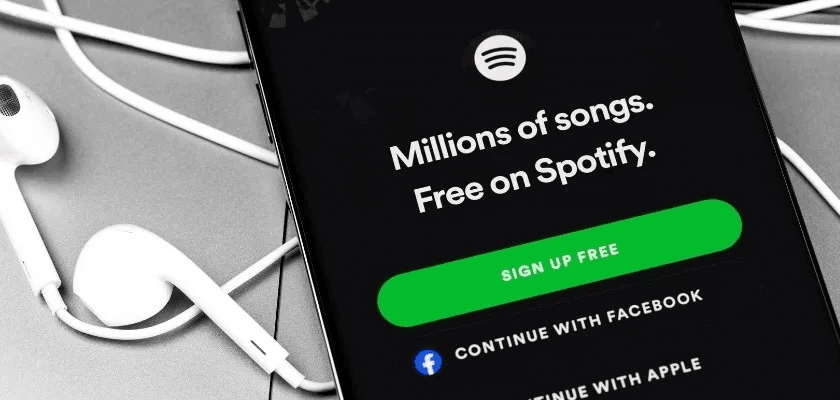
Source: Google
Spotify’s freemium model is available on both mobile devices and desktop computers, including laptops. As part of Spotify’s strategy, users receive an ad every three to five songs. These advertisements are a way to generate revenue for the company. No free user can skip the ad, play in shuffle mode, or even skip through songs without an ad.
Although this advertising can get irritating after a time, most individuals enjoy getting free items and want to tell their friends about it. Spotify is being talked about among brand marketers in the hopes of marketing their brands through the service because it has a platform that can promote to millions of consumers.
Usage of Data
Spotify has used the tools of technology and data like no one else. A key element of Spotify’s strategy is its algorithm, which is expertly designed to help users discover new music and expand their playlists. By tracking users’ behaviours, interests, and listening history, Spotify’s algorithm creates personalized playlists and offers tailored music recommendations, making each user’s experience unique.

Source: Google
The most surprising part is the efficiency of Spotify’s algorithm which enhances the user experience without requiring any extra effort or fees. All one needs to do is use the platform as their regular music-playing app and the algorithm will pick it up and send you recommendations according to your behaviour. This also highlights the value of Spotify’s strategy in promoting its paid service, offering users an unparalleled listening experience from the moment they hit play.
These loyal users tend to tell others, family, and friends about the app automatically marketing the product. Of course, Social Media marketing has played a big role in these marketing strategies. And we will also discuss the best ads since 2016.
Marketing Strategies of Spotify
Spotify employs a data-driven marketing strategy that focuses on personalisation, user engagement, and global reach. Their ‘Wrapped’ campaign, which allows users to share their yearly listening habits, has been incredibly successful. An analysis of Spotify’s marketing campaigns shows a significant increase in user engagement and brand loyalty, reinforcing Spotify’s position as a market leader.
1. SEO Strategy
Spotify’s website and app are optimized for search engines with relevant keywords and high-quality content, enhancing organic traffic and visibility as part of Spotify’s marketing strategies.
2. SMM Strategy
Spotify’s social media marketing strategy includes interactive posts, influencer collaborations, and user-generated content to boost engagement and brand presence.
3. Ecommerce Strategy
As part of Spotify’s marketing strategy, the seamless integration of subscription options and exclusive content offerings on the platform enhances user experience and drives conversions.
4. Mobile App
The Spotify app provides personalized recommendations, offline listening, and exclusive features for premium subscribers, all of which are key components of Spotify’s marketing strategy to drive high user retention rates.
5. Influencer Marketing Strategy
Another marketing strategy of Spotify that helps it retain users is constantly collaborating with artists. This not only increases their audience base but also gives them exclusive content. While this technique is well-known, it’s not widely practised. Spotify not only included visual and audio elements in their songs for free, but it also help artist’s in making their work more accessible to their listeners. This is a major reason that more and more artist small to big want their music to be published on Spotify.
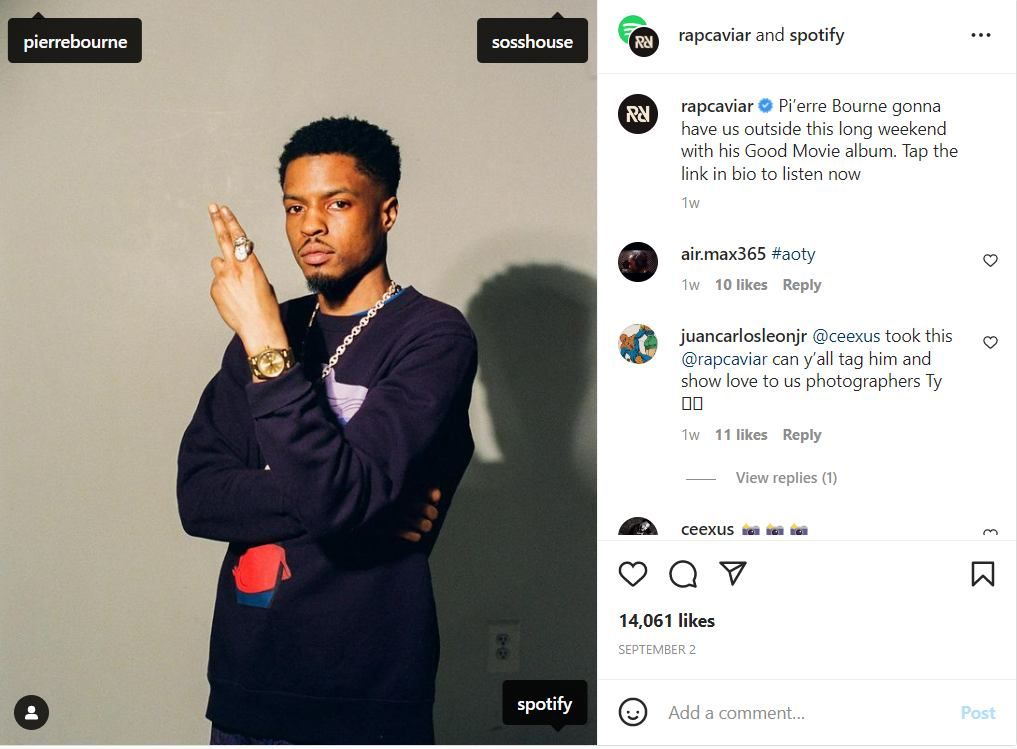
Source: Instagram.com
As streaming services become increasingly competitive, all businesses must work to provide value to their customers. As a part of Spotify’s marketing, the company produces excellent content that people appreciate and sustains that momentum by delivering the most tailored experience possible to its clients. This approach is what makes Spotify stand out from all its competitors.
In 2020, as people spent more time at home, the podcast community began to grow its audience, and Spotify’s strategy was quick to capitalize on this trend. Spotify not only entered the podcast streaming market but also secured deals and contracts with big names like Joe Rogan. Additionally, figures like Robert Downey Jr., Elon Musk, and Mike Tyson have been featured in podcasts that are exclusively available on Spotify, further solidifying the platform’s dominance in the market.
6. Social Media Marketing
Spotify’s social media marketing is so well-created and maintained that every music lover appreciates and enjoys it. Spotify’s marketing ensures that users are regularly updated about new albums and launch dates, creating a constant buzz around the platform. As part of its marketing strategy, Spotify also promotes new artists, supporting both the artists and the platform simultaneously.
With various social media handles tailored to different geographical areas, Spotify’s marketing reaches and resonates with audiences worldwide. This consistent branding across these platforms and the use of hashtag campaigns helps Spotify further enhance brand awareness and visibility.
Influencer marketing on social media platforms has been one of the most successful collaborations ever seen, and Spotify’s marketing strategy has effectively leveraged this by running sponsored ads with the help of influencers.
In 2017, the company launched the global hashtag campaign #2018Goals, sending a message that 2018 would be a fun and upbeat year filled with rhythm. By tapping into the trending #Goals movement, they cleverly capitalized on the idea to boost their popularity.
Do you find this article insightful? Check out our digital marketing blogs now!
Marketing and Advertising Campaign Designed by Spotify’s Marketing Strategy
Spotify Wrapped
As part of Spotify’s marketing strategy, the company introduced the ‘Wrapped’ campaign, a highly personalized and interactive end-of-year experience that has become synonymous with the brand.
In December 2023, Spotify’s ‘Wrapped’ campaign became a cultural phenomenon, allowing users to relive their musical journey throughout the year. This marketing strategy aims to deepen user engagement by offering personalized insights into listening habits, including top songs, artists, genres, and podcasts. The campaign cleverly combines user data with shareable content, encouraging social media virality.
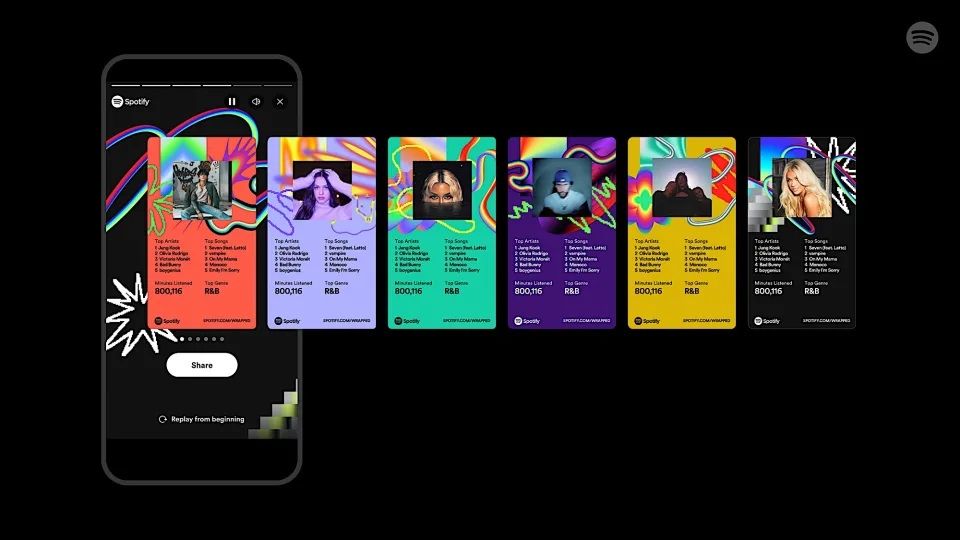
Source: Google
Spotify’s ability to tap into the power of personalisation and user-generated content has made ‘Wrapped’ a significant success, helping the platform strengthen its connection with its global user base, especially among younger audiences who value unique, tailored experiences.
The ‘Wrapped’ campaign not only drives user retention but also boosts brand loyalty, as it positions Spotify as more than just a music streaming service - it’s a part of the user’s personal identity.
Listening Together
Launched during the global pandemic in 2020, Spotify’s ‘Listening Together’ campaign was designed to emphasize the shared human experience through music, even in times of physical isolation.
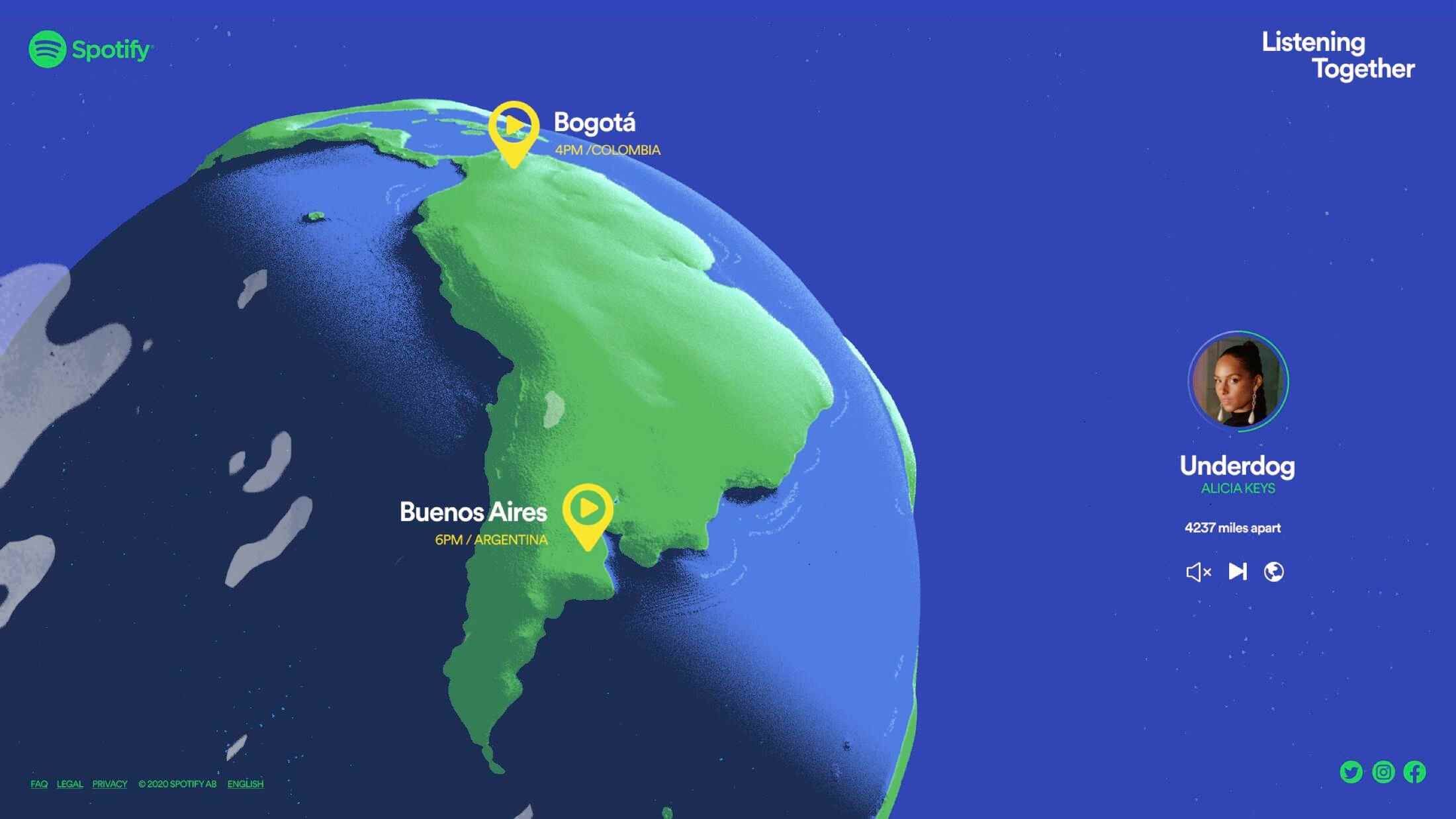
Source: Google
The campaign revolves around the concept of “when two people start playing the same song at the same time, they create a connection.” Spotify used this idea to create a global movement where users could see in real time when and where others were listening to the same tracks. This was supported by curated playlists and artist collaborations that highlighted the universal power of music to bring people together.
Listening Together not only resonated deeply with users seeking connection during challenging times but also reinforced Spotify’s brand as a community-driven platform. The campaign was a reminder of music’s ability to unite people across the world, turning individual listening moments into shared experiences, thus strengthening Spotify’s emotional connection with its audience.
Want to study the marketing strategy of other brands? Check out our digital marketing case studies now!
The Marketing Campaign of Spotify That Failed
In 2018, as part of Spotify’s marketing strategy, Spotify introduced the ‘Hateful Conduct Policy.’ The policy aimed to remove or limit the promotion of artists whose behavior was deemed hateful or offensive, reflecting Spotify’s commitment to aligning its brand with social values and ethical considerations.
Issue: Spotify’s 2018 ‘Hateful Conduct Policy’ faced backlash for being perceived as censorious and inconsistent.
Backlash: The policy led to criticism from artists and users, resulting in negative media coverage and user dissatisfaction.
Response: Spotify retracted the policy and issued a public apology, reaffirming their commitment to artist expression and user experience.
Top Competitors
Spotify is not the only company that dominates the music streaming industry. There are many other players that can have a huge impact on Spotify’s marketing strategy:
- Apple Music: Known for its integration with Apple devices and exclusive releases.
- Amazon Music: Offers a vast library and is integrated with Amazon Prime, making it a strong competitor.
- YouTube Music: Combines music streaming with video content, appealing to a broad audience.
- Tidal: Focuses on premium sound quality and exclusive content from artists.
- Pandora: Provides personalised radio stations and a strong user base in the US.
Learn From Asia’s #1
Digital Marketing Institute
AI-Based Curriculum
Dive in to the future with the latest AI tools
Placement at top brands and agencies
